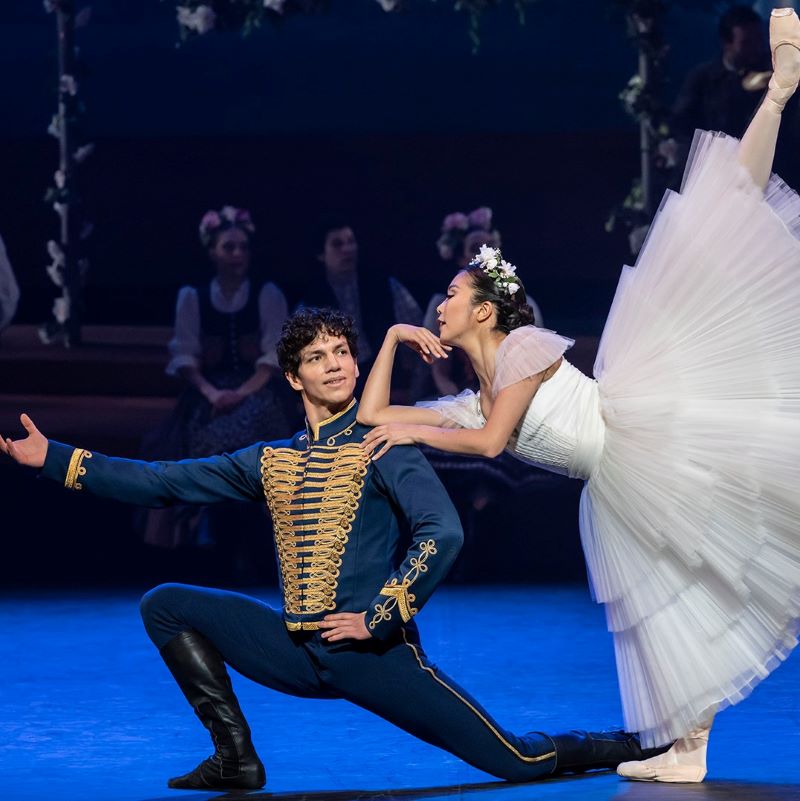by Joy Richardson.
Despite being considered a standard of classical ballet Raymonda, which was first performed in 1898, tends to only be seen in excerpts today and it has never before been performed in full in this country by a UK company. Keeping the original score of Alexander Glazunov and drawing on the classic choreography of Marius Petipa (also famous for Swan Lake and the Nutcracker) Tamara Rojo’s chorographical debut follows from their own practice as a dancer faithfully recreating the steps of Pepita whilst bringing the production up to date with new, modern athletic, movement. The dramaturg from Lucinda Coxon also aims to modernise moving the story through time from its original setting during the crusades to the Crimean war.
The ballet is divided into three acts, the first starting with Raymonda (Emma Hawes), a young wealthy Victorian reading about the war in Crimea in the newspaper at home in England and meeting a family friend John (Aitor Arrieta) who is leaving to fight. She quickly decides her purpose lies in nursing the troops and after some rather charming animated exposition we join her and her friends the cheeky Henriette (Julia Conway) and more the stern Sister Clemence (Precious Adams) at a camp in Stevastopol. Here the troops, in their immaculate identical frogged uniforms perform the first of Rojo’s new choreography, gaining great height for some spectacular entrechats and tour en l’air.
Raymonda encounters John again at the camp and they dance, sweetly, for the first time with an (intended) awkwardness and naivety we could all recognise from the early stages of a romance. However it is the solo performance of Adams which stands out in this section. Sustained mostly en pointe she steps and fouettes between elegant extensions with incredible skill. John then leaves to fight entrusting Raymonda into the care of his handsome friend Abdur (Rentaro Nakaaki). The end of this act features a dream scene lead by the magical playing of the harpist (Isobel Frayling-Cork).
Act Two takes place at Abdur’s house. He is throwing a party and Raymonda, with her friends, attend. Nakaaki introduces us to Abdur properly with his solo which is a striking contrast to the style of the British troops. He remains low to the ground, but exhibiting no less skill. His movement is powerful, considered, sensual even. I reflect here how showy and pompous John’s vertical leaps now seem. Impressive for sure but stilted and empty compared to the flow and intensity of Abdur. Raymonda is obviously impressed too and they come together in a duet far removed from that of her and John. They move with passion and confidence but the party is broken up as the troops return and John, obviously wounded, falls at Raymonda’s feet.
For Act Three we are back in England for the wedding of Raymonda and John but Abdur throws a spanner in the works by turning up too. The newlyweds dance but again the (still intended) awkwardness is there, they aren’t in sync, their movements aren’t complimentary. With Raymonda in mental turmoil over the two men Hawes performs her highlight solo. Up until this point she hasn’t had the opportunity to really show how accomplished a dancer she is but this is breathtaking. Petipa’s original choreography shines with clear echoes of The Dying Swan, perhaps his most famous piece, it is evident they are contemporaneous. I won’t give you any spoilers but the ballet ends with Raymonda ultimately making the best decision.
As a lifelong ballet lover it was a wonderful opportunity to see Raymonda performed in full. Story setting in 1850s manages to keep the classical feel whilst being more relatable to a modern audience. Knights and damsels feel a bit far-fetched but a nurse falling for a soldier (or two) during wartime is easier to empathise with. But I’m not sure about Coxon’s dramaturg. Rojo has understandably changed the, potentially problematic, original story and claims inspiration from real Victorian nurses in Crimea yet I feel we miss the horror witnessed and loss felt by these women, and all medics on the battlefield and in war hospitals. However Glazunov’s score was performed beautifully by the extensive orchestra and the dancers moved skilfully, mastering what is undeniably technically challenging choreography from both Petipa and Rojo. Precious Adams remained my leading performer of the night.
- Raymonda runs at Mayflower Theatre, Southampton, until December 3.
- In Common is not for profit. We rely on donations from readers to keep the site running. Could you help to support us for as little as 25p a week? Please help us to carry on offering independent grass roots media. Visit: https://www.patreon.com/incommonsoton

